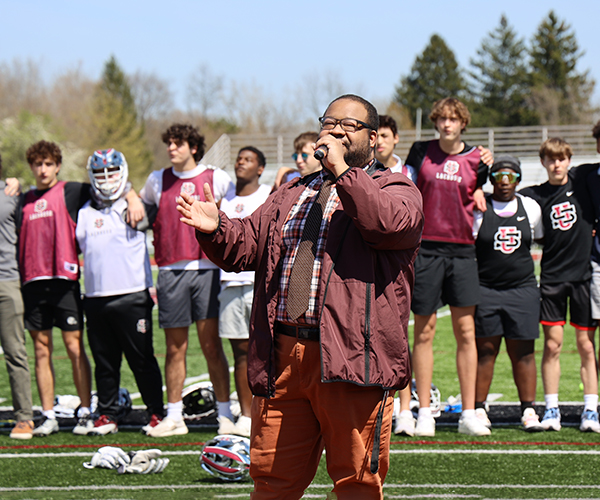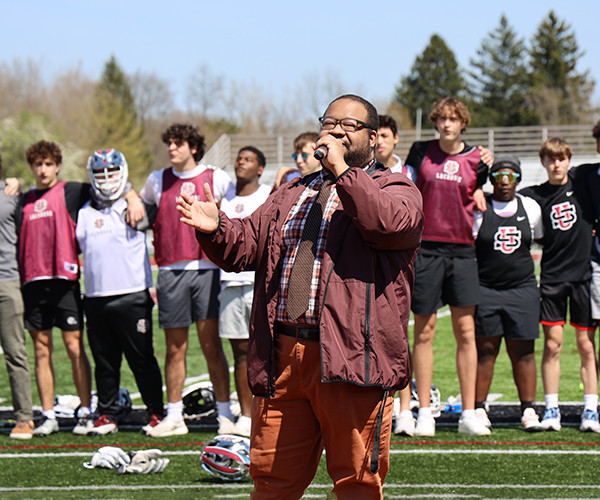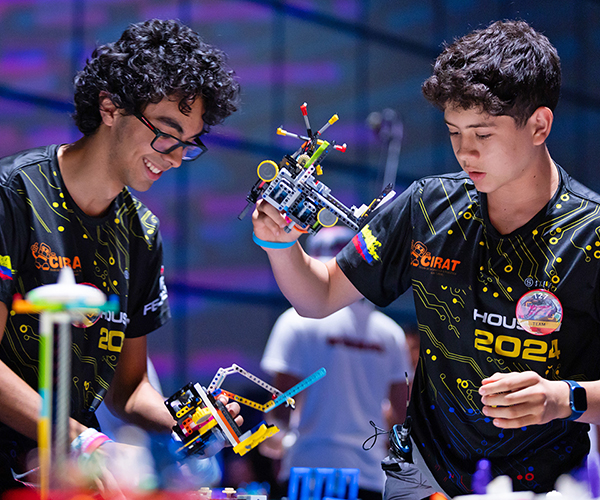Dressed in dark teal scrubs, Allie Pirrone rolls a digital blood pressure monitor into patient Sam Niro's room at Marymount Hospital. Pirrone's youthful face gives away that she is much younger than any other nurse or assistant who has come into his room today.
That's because Pirrone, a junior at Trinity High School, is participating in the school's 2-year-old pre-professional internship program, which helps pay part of her tuition. Pirrone and the rest of the Trinity sophomores, juniors — and next year — seniors, do internships in health care, animation and design, information technology or college and career readiness.
Niro spots the Trinity identification badge she's wearing and smiles. "My son went to Trinity," he tells her as she slips the cuff onto his forearm and presses the button.
They continue talking as she finishes taking his readings, and the two discover that they once were neighbors on the same street in Maple Heights before Pirrone's family moved to Sagamore Hills and Niro relocated to Broadview Heights.
"It's always nice to see a young person who wants to work," Niro says.
Pirrone, who plans to major in occupational therapy, says working as a nurse's aide at Marymount reinforces what she's learned in her medical terminology and medical science and technology classes and has prepared her for the field.
"If a patient has to go down for a test, you know what it is," she says. "I understand stuff more because I see how it works."
Indeed, seeing how science, technology, engineering and math learning can be applied in real-life situations will encourage more children to pursue careers in those fields, says Michael Foreman, chief of external programs at NASA Glenn Research Center. Foreman, who grew up in Wadsworth, flew on space shuttle missions in 2008 and 2009.
He was inspired by John Glenn and now speaks to students to try to create that same spark. "It's showing them what the people here get to do with their science, engineering, math backgrounds and having these kids take that back to the classroom and say, 'You know, if I study hard and get a degree in math, science, engineering, I can be out there working with the gee-whiz stuff those guys get to work with,' " Foreman says.
That's welcome news for those who, like President Barack Obama, are pushing to improve the showing of American high school students in math (25th) and science (17th) compared to the rest of the world.
It is, in fact, what Obama referred to in his January State of the Union address as "our generation's Sputnik moment," calling for investments in education and innovation, particularly in science, technology, engineering and math to move the country forward, much like what happened after the Soviets launched the first satellite, Sputnik, into space in 1957.
It reaffirmed his 2009 Educate to Innovate campaign to raise American students "from the middle to the top of the pack in science and math in the next decade."
In Ohio, officials were already moving on a strategy of their own.
In 2008, the state created the Ohio STEM Learning Network, which included schools devoted exclusively to science, technology, engineering and math education, including Cleveland Metropolitan School District's MC2STEM and Akron's National Inventors Hall of Fame School. And this year, Ohio's curriculum got an overhaul that required, for example, four years of math, including Algebra 2, for all students.
To realize these opportunities, Stan Heffner wants us to start thinking of engineering as a verb.
As associate superintendent, Center for Curriculum and Assessment at the Ohio Department of Education, Heffner is pushing for an idea he calls "STEM for all." In other words, we need to raise standards for education in all schools by focusing on problem-solving and reasoning skills rather than rote memorization.
"How do I anticipate? How do I build on past knowledge? How do I know that there's good evidence and bad evidence and know the difference between the two?" Heffner asks. "Those are things you'll find in the new academic content standards."
And it's the kind of thinking that's already happening in places like St. Edward High School, Laurel School and others throughout Northeast Ohio.
St. Ed's offers three one-semester pre-engineering classes and plans to bolster its offerings with additional staff training in the International Baccalaureate Design Technology curriculum over the summer.
The goal is a more integrated method that combines disciplines to give students a more rounded engineering experience, Falk says. "We try to incorporate everything into our classes."
Similarly, Laurel has grown its engineering offerings from one course to four in recent years, including a new computer science course this fall.
Consider the juniors in Licia Kovach's second-year engineering class, for example. They designed a playground with a traditional swing set, a tire swing and climbing rope for an orphanage in Tanzania as part of a service project with a group called the Olevolus Project. Laurel students have made three trips to Tanzania to help the people of Olevolus Village.
The engineering students built scale models and selected materials through research and Skype conferences with the director of the nonprofit orphanage in Olevolus Village.
And by conducting a cost analysis, the girls figured it would be cheaper to pack the heavy chains and swings as baggage on their commercial flight than ship it separately. So in June, 16 students and three chaperones made the 25-hour trip to the west coast of Africa with the playground equipment packed in their suitcases.
There was only one problem: When they arrived, they discovered the available wood wasn't thick enough to build the project as designed.
"It was a matter of re-engineering right on the spot," Kovach says. "They hammered two pieces together and made it work."
Similarly, Laurel's Center for Research of Girls has added to the student experience by applying what it knows about STEM learning differences in boys and in girls.
Because girls have less spatial reasoning and don't tinker as much as boys in childhood, Laurel has created three stations throughout where students can play with Rubik's Cubes, circuitry or knots.
"Boys see technology as a toy; girls see it as a tool," says Larry Goodman, Laurel's director of strategic programming. "So if you focus your lesson on technology, boys love it. They think it's cool. Girls find it meaningless."
Make it applicable in the real world, however, like the Tanzania trip, and everything changes.
Laurel junior Kristen Nemeth, for example, created a computer program to determine the best arrival time to get a parking space in the school lot. She used sensors in the lot that would report the number of cars as they arrived and left to a Google Docs spreadsheet, generating a chart. The program was sophisticated enough to recognize a car, rather than a bicycle or dog that might pass the sensors.
That's why NASA Glenn partners with the Cleveland schools' MC2STEM High School, provides professional development for teachers and brings students to its research center for workshops and shadowing opportunities.
"We're inspiring the next generation of STEM workers," says Carolyn Hoover, NASA Glenn's STEM school coordinator. "NASA, and indeed the country, has a need to replenish our work force and inspire area youth of the nation to dream big."
Devonte Watkins, a junior at MC2STEM from Collinwood, is a prime example. When he learned he'd be attending school year-round, 10 weeks on, three weeks off, he wondered if he could handle it. But Watkins has thrived at MC2STEM, even becoming the Cleveland Metropolitan School District's first Senate page.
"We talk about the sacrifices that you make in order to be successful," says principal Jeff McKellan. "And, for the most part, they're willing to make them."
MC2STEM freshmen attend school at the Great Lakes Science Center with frequent visits to NASA Glenn headquarters; sophomores are at GE Lighting's Nela Park; and, next year when renovations are completed, juniors and seniors will attend classes at the former Jewish Community Federation building, though most seniors will be on internships or taking college classes at Cleveland State University or Tri-C.
MC2STEM emphasizes understanding across disciplines and requires students to receive a 90 percent or better in a unit before moving on. "There are tests, there are essays, but it's more," says McKellan. "You need to know how to solve this problem."
For example, on a sound project, students worked together to build speakers, using math and engineering skills. Then in art, they developed a brand and logo for their speaker company. In English class, they looked at the poetry of song lyrics and wrote a technical manual. Finally, they tested out the speakers at the Rock Hall.
"We work in teams because we know that successful leaders in the 21st century don't work in isolation very often," McKellan says.
For the sophomores at GE Lighting, that translates into a buddy system where MC2STEM students are paired with a GE employee for a meeting or lunch twice a month. To further this experience, students are given 25 days to create a business plan and working prototype of a lighting product, says Andrea Timan, STEM/community programs manager for GE Lighting.
These methods aren't limited to high schools either.
In Akron, the National Inventors Hall of Fame School opened with fifth-graders and sixth-graders in fall 2009 and by next fall will serve fifth through eighth grade.
"Kids really start to make decisions once they get into that middle school range about whether or not they're good at something, like 'I'm great at math' or 'I'm no good at math,' " says principal Traci Buckner. "We really wanted to catch the kids before they got to that point."
And being surrounded by the work of inventors certainly has its advantages. When too much noise was rising from the school's Great Hall to the Learning Commons above it, the librarian asked a group of fifth-graders to come up with a way to dampen the sound. One of the students suggested calling Jim West, the inventor of the electret microphone to help them learn about sound-absorbing materials.
Short was in the catheterization lab at University Hospitals Case Medical Center watching Dr. Sahil Parikh snake a catheter through the neck of a patient who had a metal fragment pierce his heart. Parikh lassoed the metal piece that had broken off of an inferior vena cava filter — a device implanted in a vein to prevent blood clots from reaching the heart — and pulled it out, saving the patient from riskier and more difficult open-heart surgery.
The procedure was so rare, and performed with such finesse, that the technicians applauded.
"It was pretty clear the minute Jonathan came into the cath lab with us that the lights went on, and you could see right away that he had really caught fire," Parikh says. "That's a moment we all live for as educators. We have the unique privilege of working with medical residents and fellows who are in their last days of training, but it's relatively unusual to work with high school students."
Yet more teens are getting the opportunity to do just that. Students such as Hathaway Brown's Adriana Zinn and Hawken School's Catherine Blebea and Joe Soltzberg are working in research labs at CWRU and have each already published or have had accepted research papers in prestigious medical journals.
Soltzberg and Blebea participated in Hawken's STEMM Pathways program (the extra M is for medicine), a seminar-style course that teaches students about research — everything from writing grant proposals to working in labs and writing results.
Soltzberg jokes that he had planned to become a rock star until he worked in a lab studying cystic fibrosis and developed a computer program to help measure and assign a percentage to the level of inflammation present.
Now, he will go to Cornell next year to major in engineering, though he's not yet decided on the type.
Blebea studied the HRT2 gene's impact on cell growth and has had a paper accepted in the Journal of Surgical Radiology on a rare form of mycotic aneurysms. But Blebea, the daughter of two doctors, sums up STEM best when she says that it's not the same as just ramping up traditional science curriculum.
"The difference is in most of the biology and physics classes I've had, there was a set curriculum: You know this formula and these elements," she says. "That gives you a foundation, which is very crucial, but there's not as much hands-on.
"It's more interesting to learn about what's going on in the world," she continues. "What are people finding out and how is our knowledge changing?"
For his part, Short says Parikh changed his life just by caring enough to spend so much time with him.
The two met through a program sponsored by the Joan C. Edwards Foundation and CWRU School of Medicine that provides tutors and shadowing experiences to Cleveland schools students, many who plan to go to medical school.
"He would sit down and explain everything to me, almost to the point where I felt I could go in and do one," says Short, who will be the first person in his family to attend college.
He has applied to Case Western



